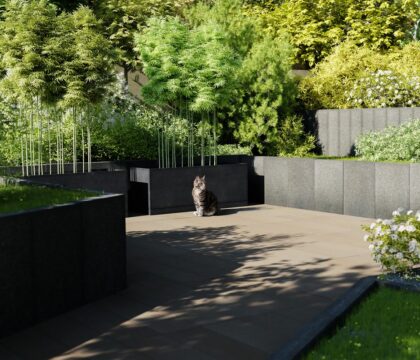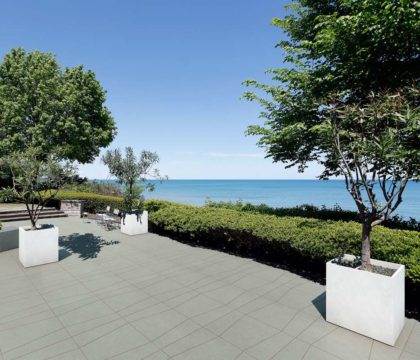
Architectural concrete planters come in many formats, shapes and colors. However, they all have one thing in common: the raw beauty and uniqueness of the material they are made of, durability, stability and resistance to weather conditions. If you add to this the minimalist design and the fact that concrete works really well with nature, you get a complete answer to the question of why concrete platers appear in gardens so often.
In modern arrangements, planters can be used in many ways. Let’s see how they grow to be the main star of the garden and how they act as a distinctive utility-design element in the garden.
Concrete planters look very good individually, but they present their full modern charm when combined together. Interesting compositions of different colors, geometric shapes and sizes make them grow to the rank of the leading element in the garden arrangement. They are the focus of all attention, and they are what makes a project attractive. They give it elegance, fitting perfectly in modern green arrangements, thanks to their minimalist design. Short cut grass, decorative stones, bark, evergreen plants, simple geometric paths, wood – these are the best companions for concrete planters. Together they are a great solution for green spaces arranged in modern style.
Architectural concrete planters most often appear in the garden or on the terrace as a functional and decorative detail. Depending on the color and format, they can either blend into the background like a chameleon, complementing the arrangement (gray colors) or highlight it with an interesting detail (white, black). Their simple forms without any decorations are particularly well suited to gardens in a modern style, which are dominated by order and geometry. Concrete is great for emphasizing the natural beauty of plants, planters made of it are very well suited for various roles: thanks to the different sizes available, they can accommodate larger and smaller plants. They will create a flowering balustrade on the terrace, separate different parts of the garden from each other, and become the central point of the terrace.
 Regular Planter white natural
Regular Planter white natural
 Regular Planter with saucer concrete natural
Regular Planter with saucer concrete natural
 Regular Planter concrete natural
Regular Planter concrete natural
 Regular Planter steel, carbon natural
Regular Planter steel, carbon natural
 Regular Planter concrete natural
Regular Planter concrete natural
 Big Planter white natural
Big Planter white natural
 Big Planter white natural
Big Planter white natural
 Regular Planter with saucer white natural
Regular Planter with saucer white natural
 Regular Planter steel natural
Regular Planter steel natural

Color shades: gray, graphite, white
Material: architectural concrete - 100% handmade
Usage: outdoor, interiors

Color shades: gray, graphite, white
Product type: bench-planter

Color shades: gray, graphite, white
Material: architectural concrete - 100% handmade
Usage: outdoor, interiors

Color shades: gray, graphite, white
Product type: bench-planter

Color shades: gray, graphite, white
Material: architectural concrete - 100% handmade
Usage: outdoor, interiors









